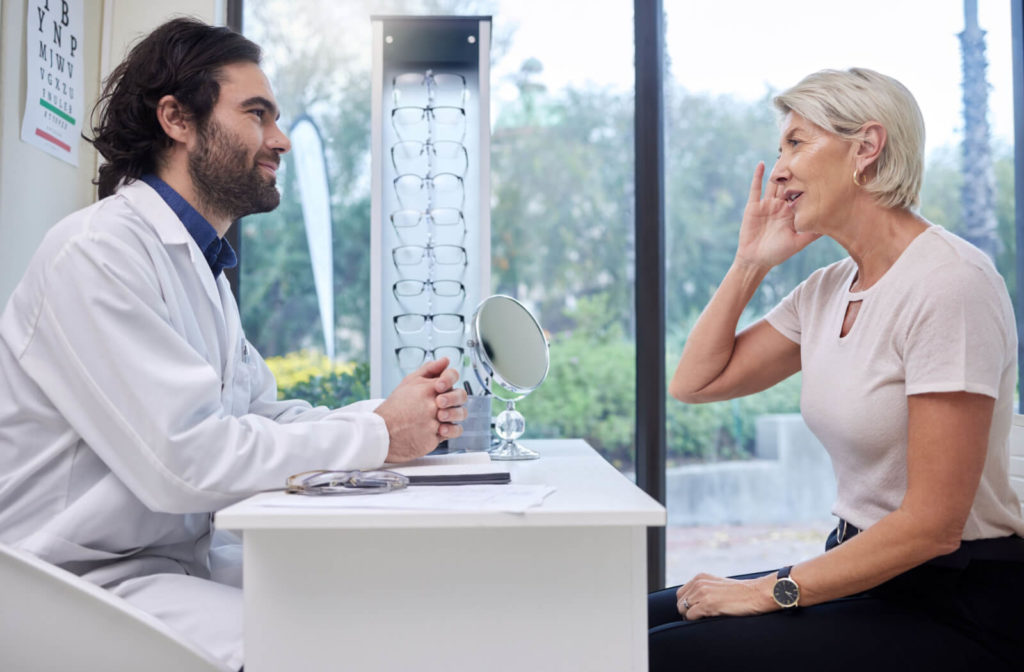If you’ve ever felt that stinging and burning sensation in your eyes like they’re irritated and inflamed, you’ve likely experienced dry eye. It’s a common eye problem that can be treated with the help of your optometrist. However, if you’re looking for temporary relief, there’s a simple answer: eye drops. But how often can you use eye drops?
There are two types of eye drops: ones with preservatives and ones without. If your eye drops have preservatives, try not to use them more than 3-4 times daily. If the drops do not have preservatives, feel free to use them whenever you need relief.
What Is Dry Eye?
Dry eye, often called dry eye syndrome or dry eye disease, is an extremely common problem in the eye caused by a problem with tear production. When your tears are working properly, they protect, hydrate, and nourish the eye while helping flush away contaminants.
These tears are made of three layers:
- The mucin layer: This is composed of mucus produced in the conjunctiva. This layer helps keep the tear film securely attached to the eye’s surface.
- The aqueous layer: This makes up most of the tear film. It keeps the eye clean by flushing away bacteria and other particles and is produced in the lacrimal glands.
- The lipid layer: This makes up the outside of the tear film. This layer prevents the tears from evaporating too quickly while keeping their surface smooth.
What Causes Dry Eyes?
A problem with this tear production can cause dry eye. Either the tears evaporate too quickly, or the eye simply can’t make enough tears. When this happens, it exposes the eye to the air, easily becoming inflamed and irritated.
When your tears evaporate too quickly, it’s called “evaporative dry eye.” This is the most common cause of dry eyes. In other situations, your eyes just can’t produce enough tears necessary to stay protected. This is often due to one of the following:
- Age, as tear production tends to decrease as you get older
- A particularly dry, windy, or smokey environment
- Certain medications, like antihistamines or antidepressants
- Hormonal changes, especially during pregnancy or menopause, which can affect tear quality and quantity
- Health conditions such as diabetes, rheumatoid arthritis, or thyroid problems
This makes it essential to get a proper diagnosis for your dry eyes. You’ll need an optometrist’s advice because there are so many potential causes.
Can You Treat Dry Eyes at Home?
If you’re living with dry eyes, there is good news: there are several ways to find relief at home. It can help to:
- Use a humidifier indoors to reduce how hard your eyes need to work to produce tears
- Stay hydrated
- Wear protective eyewear on windy days
- Follow a properly balanced diet rich in fruits, vegetables, and omega-3 fatty acids
Through these simple at-home strategies, managing dry eyes can become much easier. If you use these strategies but still experience dry eyes, there’s more good news: you can find temporary relief by using eye drops.
How to Tell if You Need Eye Drops
Eye drops can be a simple yet efficient solution for treating dry eyes. While they may not provide a long-term solution, they can be excellent for finding relief when your dry eyes are too frustrating. They give your eye both lubrication and comfort, almost acting as a replacement for your tears.
So, how do you tell if you should use eye drops? Keep an eye out for the following symptoms:
- A stinging or burning sensation in the eyes
- A scratchy feeling, like there’s something abrasive in your eye
- Redness and irritation
- Overly watery eyes (which is a response to dryness)
- Blurred vision that often improves with blinking
If you’re experiencing any of these symptoms, it can be a sign that your eyes need some help. If this is the case, eye drops might just be the answer you need.
Are Eye Drops Safe for Dry Eyes?
Eye drops generally are a safe and effective way to treat dry eyes. They come in prescription and non-prescription forms and can include preservatives or be preservative-free.
If you’re using eye drops with preservatives, try not to use them more than 3 or 4 times daily. The materials used to preserve the drops can sometimes cause irritation when overused. If you’re using drops with no preservatives, feel free to use them as needed.
If you don’t know where to start when thinking about eye drops, book a visit with your optometrist. They can recommend an appropriate brand or type depending on your unique needs. Remember to read the label of whatever eye drops you buy to make sure you’re using them correctly.

Where to Get Help for Your Dry Eyes
If you’re experiencing dry eyes and don’t know where to turn, come see our team at Total Vision Sports Arena. We can perform an eye exam, diagnose the cause of your dry eyes, and recommend the appropriate eye drops so you can find relief. Don’t suffer in silence from your dry eyes; book an appointment with us!



